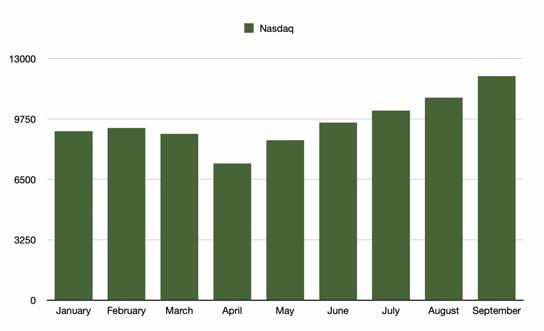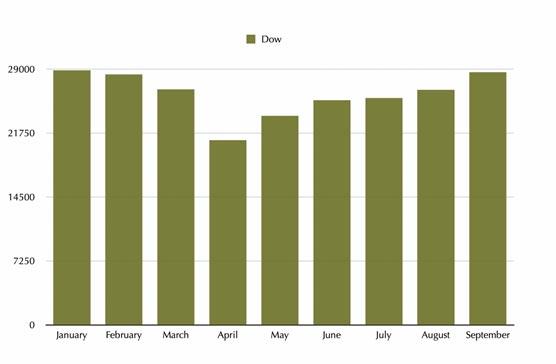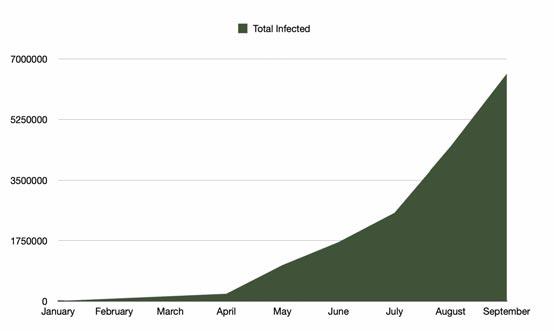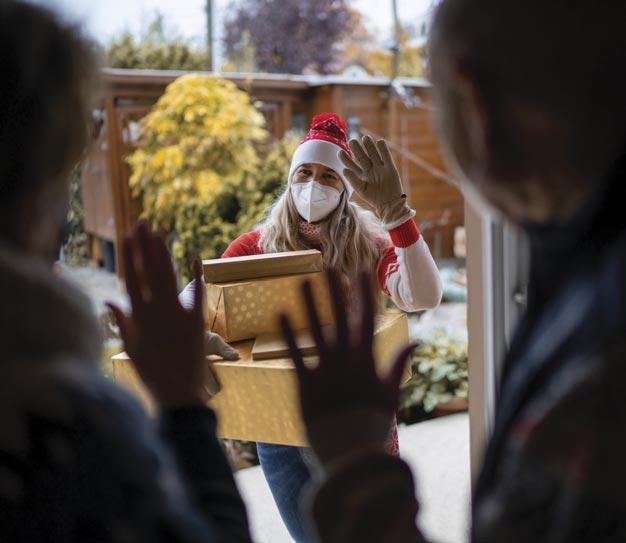
11 minute read
By John J. Seidenfeld, MD
Pandemonium 2020
By John J. Seidenfeld, MD
Advertisement
As I recap the year 2020, months seem like waves coming ashore, each one bigger than the last. At the time of this writing, more than 230,000 people have died from COVID 19 in the U.S. causing anxiety and grief (numbers in addition to expected deaths in prior years’ statistics). So many wise and wonderful people have been lost. What happens now and what lessons have we learned?
January 2020
We discovered that the vaping lung injury epidemic was attributable to a West Coast company selling vitamin E oil to rogue marijuana growers for inclusion in vaping pods. The oil received in barrels by the distributor, had a warning label “not for inhalation”. It was repackaged into smaller containers without labels and resold to cut THC put into vaping pods. Once off the market, the electronic vaping associated lung injury (EVALI) epidemic ended. Rare cases from toxic inhalants have been reported over the past ten years and will continue to dribble in.
Reports of a deadly strain of Coronavirus causing pneumonias and other serious illness were received from Chinese authorities and front-line doctors beginning in December of 2019 (after an initial coverup which often greets bad news). Life in the U.S. continued as before with no travel restrictions, but the CDC (Centers for Disease Control) went on alert and began sending out regular reports by early February for the period between December 2019 and February 2020. As I now teach at the University of the Incarnate Word School of Osteopathic Medicine (UIWSOM) and discuss topics such as Coronavirus with osteopathic medical learners, many felt no alarm and were confident that the CDC and WHO (World Health Organization) would contain the outbreak. I made plans to get together with friends in the coming months, to travel to meetings and to make reservations for summer travel. Face-to-face work continued.
February 2020
More concern was raised as reports from the outbreak appeared in the New England Journal of Medicine and Mortality and Morbidity Weekly Report from the CDC. We felt concern about
the reports of a novel virus with severe health consequences for the elderly and rapid transmission but continued to feel confident that it would be contained. I traveled to San Francisco for a medical meeting early in the month. There I stayed with family in Oakland and traveled each day on public transportation to the meeting. I began to be concerned about seasonal influenza from people near me coughing and sneezing but took no precautions beyond cringing. As the month went on, a few cases were identified in the U.S. and some precautions were taken, but travel was not banned.
March 2020
I left the office to work from home in mid-March. I turned off the lights, closed the door and thought of Pompei. Cancelled: leave requests for weddings of nieces, a weekend with out of town friends in the Hill Country, homeowner’s association meeting with neighbors, golf with friends, gym workouts, grandchildren’s schools and haircuts. My older brother died suddenly and catastrophically in a California nursing home, was buried in Chicago next to his wife, and we have delayed the memorial. We do not know but wonder about the infectious cause of his death.
We stocked up on toilet paper, hand sanitizer, canned foods, cleaning supplies, dried beans, rice, and nuts to prepare for the great unknown. Religous services and classes left the buildings and transferred to video conferencing. The virtual world has become more complex. We see images of people, hear familiar voices, but are not as coordinated as we were; a new asynchrony.
People are infected and dying in greater numbers but the death rate, testing, protective equipment, and ethical decisions as to who gets ventilators are unclear. One of my older mentally capable friends voiced concerns about whether he would receive ventilator management if needed or whether he would be a “low priority”. The national approach is to let each state respond in their own way, but is this the best or most equitable approach? Other countries have had national coordinated responses. Travel is unlikely for a long time. Those at greatest risk are living or working at nursing homes, homeless shelters, prisons and jails, meatpacking plants, and anywhere one is unable to social distance, wash hands, or take other precautions to prevent airborne spread. Clean water, soap and sanitizer, nutrition, safe housing and access to medical care have become essential to prevent infection; these are clearly the social determinants of health. Containment now is an unlikely goal.
April 2020
Basketball tournaments are cancelled, pro sports are halting as players turn COVID-19 positive, and my sports viewing habits are changing as I wean off televised games. On the plus side, I have freed up 10-20 hours each week to read, watch dramas and mysteries, talk virtually to friends and family, or do other things, online of course. I am not making trips out and am sheltering in place as we have no idea of the time course or seasonal pattern of this virus. Bexar County Medical Society (BCMS) meetings are online, so no more fighting rush hour traffic around 1604. Friends are” Zooming” 2-3 times a week to check in, and grocery stores are going online for store pickup or delivery. Small businesses and restaurants are closed and in a panic. People are losing their paychecks, jobs are shutting down and Congress is meeting emergently. Death and infection rates are rising as the U.S. becomes a major world focus, a title dubiously given by monthly infection and death tallies. A global pandemic has been declared by WHO. Travel



is blocked into and out of many areas and countries. Travelers from the U.S. are not welcome in certain common European and Asian destinations. Students are heading home from universities and living with families again. ‘Should we wear masks?’ has become a matter of political and scientific debate and people are sewing their own with “YouTube” guidance.
May 2020
At virtual work, we are examining each hour of curriculum content for four years of osteopathic medical studies. Online meetings start in the morning and fill the screen all day. We figure out how to eat meals and schedule personal need times around the ever present virtual audiovisual meeting. Telemedicine has come of age and my wife, a nurse practitioner with a VA affiliated clinic (Veterans Administration), is “seeing” patients virtually. Political parties and figures are blaming one another but solutions are in short supply. Violence against children and women, violence in the streets pitting citizens against citizens, and tensions borne of long containment are erupting. The pandemic is exposing inequities in the health care system. Memorial Day will be remembered as a time that incubated new cases as people partied like the end of the world was near and protested for and against many causes. Are we at war with ourselves? Are NIH and CDC leaders and our public health doctors our only great leaders? Are we for ourselves alone? Who will speak for those who are unable? Work on vaccines continues at a fast pace never seen before.
June 2020
A “White Coats for Black Lives” rally was held peacefully and prayerfully at UT Health Sciences Center field to raise awareness of the killing of black men and women and promoted the diversity of our medical learners. Participants kneeled, mostly holding signs displaying their own feelings but also referencing the Black Lives Matter (BLM) movement. After breaking a self-imposed quarantine for the first time in three months, I attended along with my wife, daughter, and grandchildren outdoors and distanced.
We learn now that 380,000 unscreened people came to the U.S. from China before a travel ban was put in place. Who knows how many came in from elsewhere in the world? Transmission rates of this virus are high and contact tracing is often impossible as test results return a week or more later unless you play in the NBA or work in the Administration.
July 2020
A granddaughter was in Dallas for healthcare and I did not travel to see her. It made me sad not to be with the family. Friends have been sending articles written by doctors and therapists dealing with pandemic sufferers; there is so much anguish as we are losing so many people and health care providers. The survivors are exhausted and often ill-equipped to deal with people who have multiple organ systems failing. Burnout is a rising problem. In many states, hospitals and intensive care units are at full capacity, all available ventilators are in use, and morgues are overflowing. Tents have been set up in parking lots for patients and testing, and “morgue” trucks are brought in to store the bodies of those that have died.


August 2020
School is set to start soon with confusing messages. Some state and federal leaders want everyone face-to-face but the teachers, mayors, some governors, parents, and bus drivers are balking. The CDC is sending recommendations for spacing and alternative plans including audio/video classrooms. Although operating room protocol still includes hand washing and mask wearing, some people do not understand that these measures are proposed to keep them and their families alive and do not trust the science. A few desperate people are threatening public health officials with violence if regulations such as mask wearing are not rolled back.
September 2020
A third niece is married, and the ceremony is on Zoom. I watch the beautiful bride known since her childhood through a camera broad-
casting from behind her father’s shoulder. Labor Day festivities and back to college seem to have fanned the COVID-19 flames so cases are rising again in many places. The yearly dentist, dermatologist, ophthalmologist, and audiologist visits will be delayed but I was able to get the flu shot at HEB. The politicians are blaming each other for COVID-19 blunders and deaths as the November election nears. Many worry that profit and not science will dictate the delivery of a vaccine, but drug manufacturers have banded together to assure the public that trial results will dictate the vaccine delivery. Mail-in ballots, popular because of COVID-19, are debated by partisans as being discriminatory or making the vote more secure. Politicians are questioning the ability of the postal service to carry out its duties, but I remain confident in the system.
Wildfires, gun violence, hurricanes, and rude political discourse have all contributed to high anxiety. The natural disasters, violent deaths, and social media “bots” and fear mongers have reached a level I have never encountered. Faith is being tested daily. In the Northwest, people are choking on the smoky air and in the Gulf Coast people are losing their roofs and their lives due to hurricane related flooding. Our medical learners continue to respect one another, pursue their studies and give me hope for a better day.
October 2020
I plan to venture out to get the driver’s license renewed, to visit Pompei (as I think of the office) to collect artifacts and to drive to north Texas to visit family and support them for a critical surgery. These excursions are some of my first to the “badlands” since March. Have most of us envisioned scenes from “Mad Max” since the lockdown and pandemic threat? Continuing education and air travel may wait until an immunization is available and this has been a catastrophe for that important travel industry. Many are questioning whether they will take a vaccine if one is offered. Meanwhile, the numbers of people infected and dying are rising once again in a third wave since February and hospitals are again nearing capacity.
November 2020
It is expected that late fall will bring cooler temperatures to Texas and renewed college football brought crowds together. COVID-19 infections are expected to rise and deaths continue in areas where social distancing is not possible or abandoned for social proximity. A President and Congress were elected to face a COVID-19 recession, environmental change, the COVID-19 and health care disparities, social unrest and inequality, immigration challenges, internal and international relations, security concerns both physical and virtual, aging infrastructure, and more. There is much work to be done, and we will all need to pull together to get it started. Prayers for better health, greater understanding, solutions to deep-seated problems, and a socially just and kind world are offered this Thanksgiving. Once again, crisis is disaster plus opportunity.
December 2020
This month, as all Decembers, could easily be sixty days long and still not have enough time for all to be done. Work project completions, school tests and deadlines, virtual family gatherings, Christmas celebrations, and end of the year elective procedures (which must be done in 2020 to avoid deductible expenses in the new year) are only a few goals to be accomplished. The influenza season has started but hopefully will be milder as people are wearing masks and social distancing. COVID-19 has infected millions in the US and the world. Clinical trials are promising for an effective vaccine and by the spring we hope to be immunizing many Americans. Vaccine efficacy and those who oppose immunizations are still concerns.
As we look back please reflect on those we have lost, those whose lives are irrevocably altered, how we might improve our methods of care, and the blessing of having chosen a profession which allows us to care for those in need.

John J. Seidenfeld, MD, MSHA, FACP is a member of the Bexar County Medical Society and its Publications Committee; Alexandra G. Bailey is a Biomedical Engineering Student at The University of Texas at Austin.










